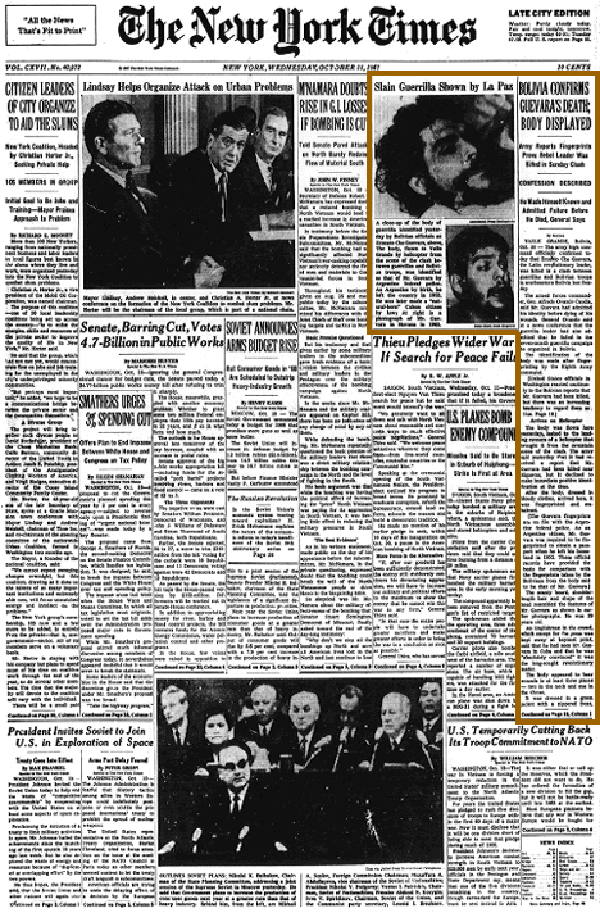 (above) Front page of NY Times of October 9, 1967
(above) Front page of NY Times of October 9, 1967
Bolivia Confirms Guevara's Death; Body Displayed
Army Reports Fingerprints Prove Rebel Leader Was Killed in Sunday Clash
October 9, 1967 - NY Times
Confession Described
He Made Himself Known and Admitted Failure Before He Died, General Says
Bolivian Army Identifies body of Guerilla Slain in Clash
Confession Made, General Reports
Fingerprints Are Checked--Admission of Failure by Rebel Leader Described
By REUTERS
Valle Grande, Bolivia, Oct. 10--The army high command officially confirmed today that Ernesto Che Guevara, the Latin revolutionary leader, was killed in a clash between guerrillas and Bolivian troops in southeastern Bolivia last Sunday.
The armed forces commander, Gen. Alfredo Ovando Candia, said Mr. Guevara had admitted his identity before dying of his wounds. General Ovando said at a news conference that the guerrilla leader had also admitted that he failed in the seven-month guerrilla campaign he organized in Bolivia.
The identification of the body was made after fingerprinting by the Eighth Army command.
[United States officials in Washington reacted cautiously to the Bolivian reports that Mr. Guevara had been killed, but there was an increasing tendency to regard them as true. Page 18.]
Arrives on Helicopter
The body was flown here yesterday, lashed to the landing runners of a helicopter that brought it from the mountain scene of the clash. The army said yesterday that it had received a report that Mr. Guevara had been killed near Higueras, but it declined to make immediate positive identification at the time.
After the body, dressed in bloody clothes, arrived here, it was fingerprinted and embalmed.
[The Guevara fingerprints are on file with the Argentine federal police. As an Argentine citizen, Mr. Guevara was required to be fingerprinted to obtain a passport when he left his homeland in 1952. These official records have provided the basis for comparison with the fingerprints taken by the Bolivians from the body said to be that of Mr. Guevara.]
The scanty beard, shoulder-length hair and shape of the head resembled the features of Mr. Guevara as shown in earlier photographs. He was 39 years old.
An Englishman in the crowd, which except for the press was kept away at bayonet point, said that he had seen Mr. Guevara in Cuba and that he was "absolutely convinced" it was the long- sought revolutionary leader.
The body appeared to bear wounds in at least three places--two in the neck and one in the throat.
It was dressed in a green jacket with a zippered front, patched and faded green denim pants, green woolen socks and a pair of homemade moccasins.
A nun assisted doctors and intelligence men in preparing the body for display. After the work was finished, the body was raised on a stretcher for the crowd, which appeared jubilant.
General Ovando arrived from la Paz and immediately went to the officers' mess to pay his respect to the four soldiers killed in the clash.
The first news of the fight was brought to Valle Grande, 80 miles southwest of Santa Cruz [CHECK] by Col. Joaquin Zenteno Anaya, commander of the Eighth Division.
Others Reported Slain
He said that six other guerrillas had been killed in the clash and that their bodies would also be brought here. He said four of them were Cubans.
Mr. Guevara was a familiar bearded figure in olive green fatigues in Havana, where he was Minister of Industries before he dropped out of sight in March, 1965.
His whereabouts since has remained a mystery, leading to rumors that he had been killed in a dispute with Premier Fidel Castro and later that he was leading guerrillas in various parts of Latin America.
His name was linked with guerrilla activity in Venezuela, Colombia, Brazil, Argentina, Peru and Bolivia.
On Sept. 10, the Bolivian President, Rene Barrientos Ortuno, described reports that Mr. Guevara was active in Bolivia as a myth. The next day he announced a $5,000 reward for his capture dead or alive.
Reports published in the press here today said that a diary believed to have belonged to Mr. Guevara was in Army hands. These reports said that the diary had been found in a knapsack owned by the guerrilla leader.
Report Ignored in Havana
A non-Cuban informant, reached by telephone in Havana last night, said that officials of the Castro regime were regarding the reports of Mr. Guevara's death as unconfirmed and were declining to comment on them. The Cuban broadcasts ignored the news, the informant said, adding: "My feeling is that the newspapers tomorrow won't publish a line."